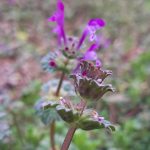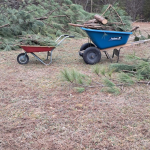Growing peach trees isn’t limited to the southeastern part of the United States. If you choose a peach tree right for your gardening zone, you too can grow fresh peaches in your yard.
Growing Peach Trees: Selecting the Right Variety
Peach trees can be grown in USDA hardiness zones 4 through 8, but do best in zones 6 through 8.
Requirements for Growing Peach Trees
- Sun: Peach trees require full sunlight, defined as six to eight hours a day of bright, direct sunshine.
- Space: Depending on the variety, peach trees usually grow 10 to 15, 20 feet or higher. The spread is also around 20 feet for the branch canopy.
- Bud formation: Buds form on peach tree branches when the tree is at least one year old. The buds swell after a period of cold, so there needs to be some weeks or months of cold weather for good fruit production. When the weather warms in the spring, the tree breaks dormancy and blooms.
- Pollination: Peach trees are self fertile, which means you can have just one peach tree and still get fruit. They are pollinated by bees, including honey bees and native bees.
- Water: Normal water is needed for mature trees. When trees are newly planted, they need more water to establish a good root system (see below).
- Propagation: Can be grown from seed or cuttings.
About Growing Peach Trees in Virginia – Our Experience at Seven Oaks Farm
Growing peaches has been one of the most rewarding aspects of planting the fruit orchard here at Seven Oaks. The ironic thing is that among the peach trees, the one we originally thought would die is the one producing fruit this year.
Planting Peach Trees
When we planted the fruit orchard trees in 2007, they came as bare root sticks called whips (I think) from the Arbor Day Society. The first year, all of the trees struggled to develop roots, but this poor peach tree never thrived. After two years it really looked as if it was going to die.
My husband wanted to build another little raised garden bed near the back patio. He came up with the idea of running a PVC pipe from the gutter and leader underground and into the soil under the raised bed. Rainwater from the roof of the house now runs directly into that garden bed and to the roots of the peach tree.
I was really on the fence with that idea. On the one hand, given Virginia’s crazy hot summers and droughts, it sounded like a good plan. On the other hand, I was concerned that the rainwater might rot the roots or over water the peach tree. The poor tree looked as if it wouldn’t make it anyway, so we decided to take a chance and complete the project.

The Orchard Today
After just about a year, that struggling peach tree took off! It now tops 11 feet tall. It is the only tree in the entire yard that has peaches. At last count, there are about 25 peaches on the tree.
Right now the peaches are turning gorgeous shades of orange-red. They are hard as a rock, so no picking and tasting them yet! I’m looking forward to the harvest. Even if they don’t taste as good as store bought, they’re MINE…grown the way I want them to be grown…not waxed, not sprayed with all sorts of scary stuff, but grown about 20 feet from my kitchen window.
And you can’t beat that for freshness.
We now have:
- 2 Red Haven peach trees (for fresh eating)
- 4 Elbert peach trees (for canning & preservation)
- 1 Belle of Georgia
- 1 Contender
Among the varieties of peaches we have grown, the best for our Piedmont (Zone 7B) garden seems to be Red Haven. The taste is extraordinary: sweet, full of ripe, peach flavor. They are great for fresh eating and seem to be a hardy tree.
Updated March 2023 with new information, links and images.




